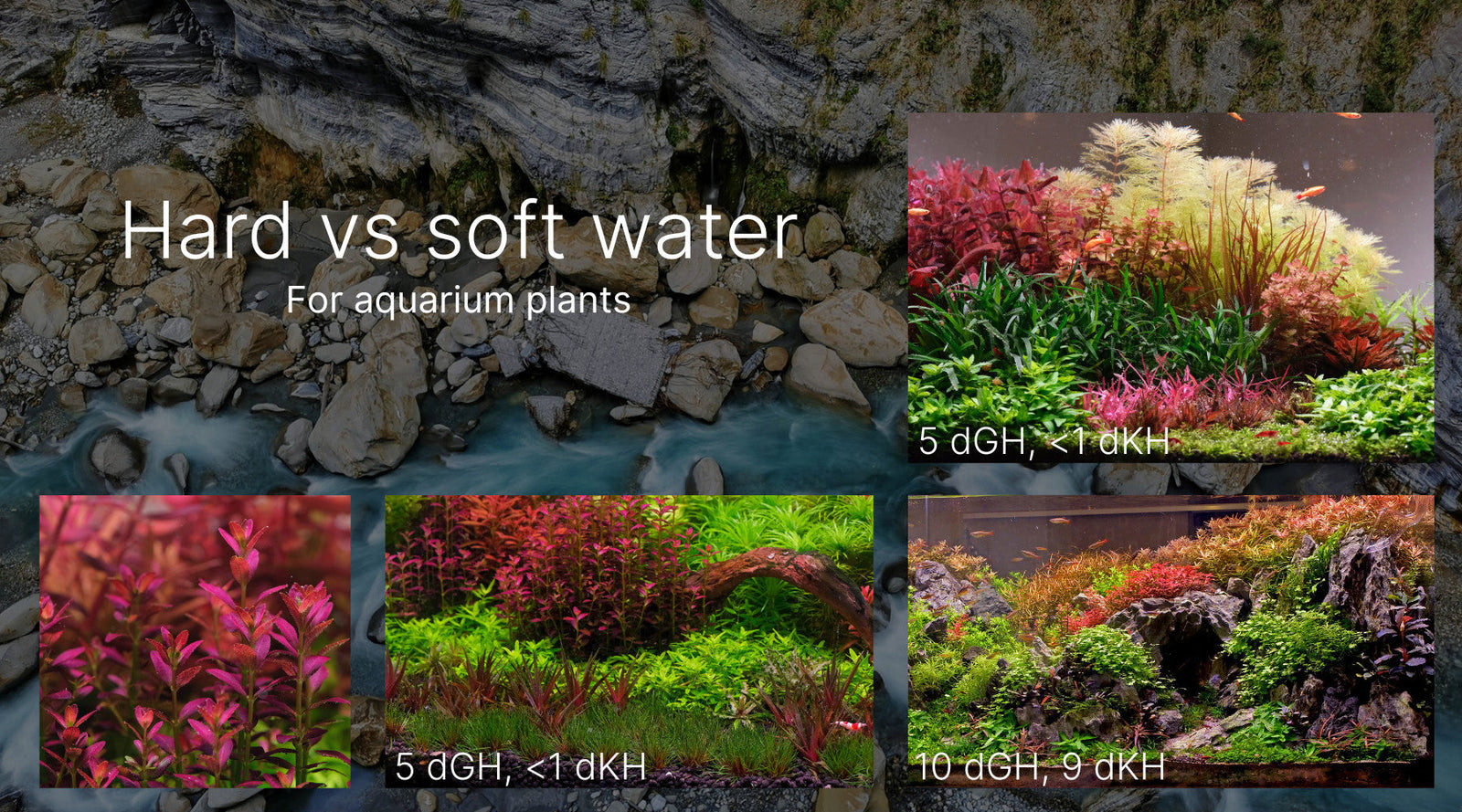Your Cart is Empty
Menu

Hard water vs Soft water plants decoded
July 18, 2025 5 min read

What is hard water?
The term hard water is generally used to refer to water with a high mineral content. This can mean that the water is either high in KH (high in carbonates) or high in GH (high in calcium/magnesium), or both. In layman's terms, it is common for hard water to be high in both GH and KH because the main factor that gives rise to hard water in nature is limestone. Limestone is common in nature and contains calcium carbonate (CaCO3). It slowly dissolves as water passes through it, adding minerals to the water. This raises both the GH and KH levels. The calcium (Ca) raises GH while the carbonate component (CO3) raises KH.
However, there are many minerals that can affect GH or KH without affecting the other. So you can have situations where GH is high and KH is low and vice versa. In aquariums we can also easily alter GH or KH independently depending on what our fish and plants require. Adding baking soda (NaHCO3) to the tank for example, raises KH but not GH. While adding Calcium sulphate raises the GH without affecting KH.

Seiryu rock, which is popular in aquascaping circles because of its nice textures, is a type of weathered limestone. When used in the aquarium, it will harden water significantly, raising both GH and KH to substantial levels. Even when RO water is used, an aquarium with Seiryu rock can raise the GH/KH to from 0 to 10 degrees within a week. How much it raises the GH/KH and what GH/KH value the aquarium stabilizes at depends on the type and amount of Seiryu rock used. This rock should not be used in aquariums where one wishes to grow soft water plants.

Seiryu rock is highly desirable due to its nice aesthetics. However, it does have a significant impact on water chemistry.
What is soft water?
As with the term hard water, aquarists use the term soft water generically to refer to water with a low mineral content. However, we should actually define the variables more precisely by GH and KH.
When a plant is designated as a soft water species in the aquarium trade, it means that the plant prefers a low KH level, with the GH being less important. A tank with 10 dGH and 1 dKH can grow sensitive soft water plant species perfectly. Whereas a tank with 1 dGH and 10 dKH cannot grow any soft water species at all. So within the context of planted aquariums, soft water requirements only refer to low KH.
KH ranges for different plants:
0-2 dKH - you have very soft water, suitable for species such as Tonina species, Syngonanthus species, Eriocaulon species, Ammania species.
3dKH - soft water, borderline for sensitive soft water species. Rotala macrandras, Bacopas will do well.
4-7dKH - medium hard water/hard water, species such as Downoi do better in this range than in soft water. Soft water species such as Rotala macrandra can still do well in certain situations.
8-14dKH - firmly in hardwater territory. Soft water plants will grow very slowly or not at all.
14dKH+ - Very hard water, more species will grow slowly or lose colour. Choosing plants that thrive in hard water is a wise choice.

Eriocaulon species tend to be picky and prefer low KH levels (less than 2dKH).

Syngonanthus species (green plant, center of picture above) need very soft water (less than 2dKH) to thrive.
What is the best GH/KH for plants?
There are a tiny handful of species that prefer higher KH levels. The large majority of aquatic plants prefer low KH levels and are downward compatible with regards to KH. Where plant cultivation is concerned, having near 0 KH accommodates the largest range of aquatic plants.
There are some species that prefer slightly raised GH such as Rotala florida, Cryptocoryne flamingo, Pogostemon helferi. Using moderate GH (5 dGH+) gives better success rates for these species. This elevated GH has no downside impact for plants that require low KH.
Thus, the best combination for growing the widest variety of aquatic plants well is moderate GH (5-7 dGH) paired with low KH (0-2 dKH).
In terms of growing plants, between 0-2 dKH you can keep sensitive soft water species. Between 2 - 5 dKH you can keep 97% of all commercial aquatic plants in optimum condition. Between 6-12 dKH you can probably grow 90% of species well, but some will be sub-optimal. Above 18 dKH or so, there are more problems with plant growth - at this level, hardy plants such as Java fern, Anubias, Vallisneria and cryptocoryne species will still grow well, but many other species will stunt or see slowed growth.
Some tank examples:
At 2hr Aquarist we have super soft tap water (3 dGH, 0.5 dKH). We raise the GH to 5 dGH using APT Sky, which raises GH without changing KH. We aiming for 5 dGH, <1 dKH for our aquariums.



Rotala tulunadensis, Syngonanthus lago grande, Eriocaulon quinquangulare and Centrolepis drummondiana all prefer super low KH (less than 2). While Rotala florida and sunset prefer slightly elevated GH levels. This aquarium runs at 5 dGH, 0.5 dKH.

All the aquariums at 2hr Aquarist aim for 5 dGH, with near 0 KH, unless Seiryu rock is used.

Limestone Iwagumi using Seiryu rock, 8-9 dKH.

Aquascape using Seiryu rock, between 8-10 dKH range. Large variety of plants still work well. Plants such as Alternanthera reineckii, and most non-demanding Ludwigia and Hygrophila species continue to grow well.

Aquascape using Seiryu rock, between 9-10 dKH.
For detailed care guide on aquarium plants, click here.
To learn more about growing softwater plants, click here.
What about livestock?
In general, fish are also more tolerant of a wide range of GH than KH. Most commercially available fish species can live in a surprisingly wide range of GH and KH. However, certain specific species, and especially their eggs and fry, may require low GH along with low KH water to breed well or show their full colour, while other species prefer much harder water. More details on this can be found in our Introduction to pH, GH, KH, TDS article.

Many species, such as these Hyphessobrycon myrmex, show better colouration when in their prefered alkalinity ranges. The tank above is at 5 dGH, 0.5 dKH.
Is there a need to buffer water to 3dKH to prevent pH swings?

There is absolutely no need to do this unless you are specifically doing this to accommodate animals that favour a certain pH/KH. Contrary to popular belief - low KH doesn't cause pH crashes without additional triggers. This is a remnant of old aquarium dogma. To read more on this topic head to our Introduction to pH, GH, KH, TDS article.
unlock your true potential
Grow anything, defeat algae, create amazing aquascapes
























